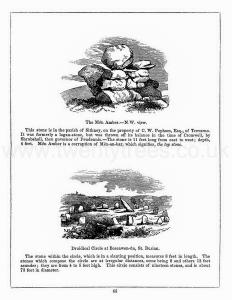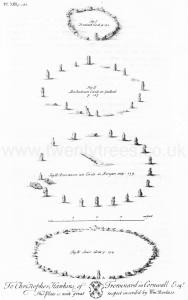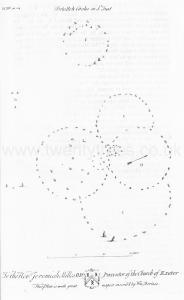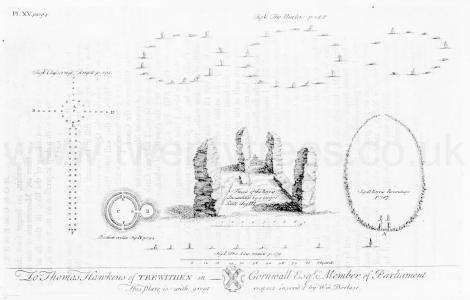South England West Stone Circles
South England West Stone Circles is in South England West, Stone Circles.
Europe, British Isles, South-West England, Cornwall, St Buryan, Boscawen-Un Stone Circle [Map]![]()
Celtic, Druidical and Roman Remains. CIRCLES.
Besides the circle at Boscawen-un [Map] (p. 65), there are several others in the neighbourhood: as at Boskednan, in Gulval; Tregaseal, St. Just; and the Dawns Mên, commonly called "the Merry Maidens," at Rosemoddress, in St. Burian; &c. They are supposed to have been connected with the religious rites of the Druids. Near the circle last named are the two large pillars called "the Pipers."
Note. Druidical Circle at Boscawen-un [Map], St. Burian. The stone within the circle, which is in a slanting position, measures 8 feet in length. The Btones which compose the circle are at irregular distances, some being 8 and others 12 feet asunder; they are from 4 to 5 feet high. This circle consists of nineteen stones, and is about 73 feet in diameter.

Europe, British Isles, South-West England, Cornwall, Boskednam Stone Circle [Map]![]()
Boskednam Stone Circle [Map], aka the Nine Maidens or Nine Stones of Boskednan, is a partially restored Stone Circles of approximately 22m diameter.
The Antiquities of Cornwall by William Borlase Chapter VII. Of these Monuments that kind was most ancient which was most simple, and consisted only of a Circle of Stones-erect. Of this fort we have a great number in Cornwall, which differ not materially from one another, Boskednan Circle [Map] therefore (Plat. XIII. Fig. ii.) may represent the whole.

Europe, British Isles, South-West England, Cornwall, Bottalack, Botallack Stone Circles [Map]![]()
The Antiquities of Cornwall by William Borlase Chapter VII. Again, some of these Circles include, and intersect one the other, as in the curious cluster of Circles at Botallek [Map], (Plate XIV.) in the seeming consusion of which I can't but think that there was some mystical meaning, or, at least, distinct allotment to particular uses. Some of these might be employ'd for the Sacrifice, and to prepare, kill, examine, and burn the Victim, others allotted to Prayer, others to the Feasting of the Priests, others for the station of those who devoted the Victims: Whilst one Druid was preparing the Victim in one Place, another was adoring in another, and describing the limits of his Temple; a Third was going his round at the extremity of another Circle of Stones; and, likely, many Druids were to follow one the other in these mysterious Rounds: Others were busy in the Rights of Augury, that so all the Rites, each in it's proper place, might proceed at one and the same time, and under the inspection of the High-Priests; who, by comparing and observing the indications of the whole, might judge of the Will of the Gods with the greater certainty: Lastly, that these Circles intersected each other in so remarkable a manner as we find them in this Monument, might be, to intimate that each of these Holy Rites, though exercised in different Circles, and their own proper compartments, were but so many Rings, or Links, of one and the same chain, and that there was a constant dependance, and connexion betwixt Sacrifice, Prayer, Holy Feasting, and all the several parts of their Worship.

Europe, British Isles, South-West England, Cornwall, St Cleer, The Hurlers Stone Circle [Map]![]()
The Hurlers Stone Circle [Map] is three stone circles in Cornwall on a line from SSW to NNE with diameters of 35, 42 metres and 33 metres. The two outer stone circles are circular. The middle circle, the largest is slightly elliptical. The earliest mention of the Hurlers was by historian John Norden, who visited them around 1584.
The Antiquities of Cornwall by William Borlase Chapter VII. Of this kind is the Monument call'd the Hurlers [Map], in the Parish St. Clere, Cornwall, the Stones of which, by the vulgar, are suppos'd to have been once Men, and thus transform'd, as a punishment for their hurling upon the Lord's Day.1 This Monument consisted of three Circles from which many Stones are now carry'd off; what remain, and their distances may be seen (Plate XV. fig. vi.).
Note 1. Hurling, is playing with a Ball, and endeavouring to get at the Goal with it before one's Antagonist; an antient tryal of Strength and Swiftness among the Cornish.
